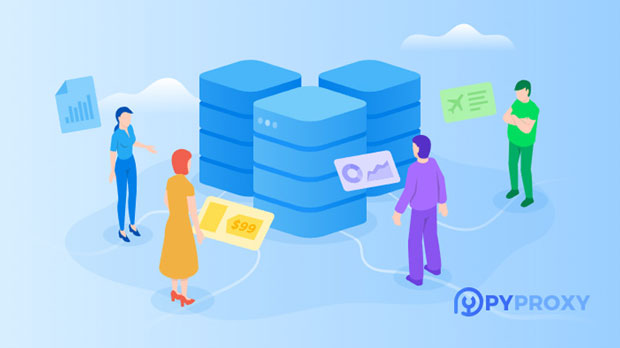Why do I need to use a static IP proxy server?
In today’s fast-paced digital world, the demand for secure, efficient, and stable internet connections is greater than ever. Whether it’s for business operations, personal use, or data scraping, having a reliable IP address is essential. Static ip proxy servers are a solution that can meet these needs. Unlike dynamic ip proxies, which change periodically, static IP proxies provide a permanent and consistent address for users. This can enhance the security, anonymity, and performance of your online activities, making them an essential tool for various purposes. In this article, we will explore why you need to use static IP proxy servers and how they can benefit your online operations. What is a Static IP Proxy Server?Before diving into the reasons why static IP proxy servers are essential, it’s important to understand what they are. A proxy server is an intermediary between a user and the internet. It acts as a bridge, routing requests and responses between the user and the internet. A static IP proxy is one where the IP address remains the same over time, unlike dynamic proxies, where the IP changes regularly.In simpler terms, when you use a static IP proxy, your online activities are routed through a fixed IP address. This consistency can provide a range of benefits that dynamic proxies cannot offer.Benefits of Using a Static IP Proxy Server1. Improved SecuritySecurity is one of the primary concerns for internet users, especially businesses that rely on online transactions and sensitive data. Static IP proxies offer enhanced security for users by masking their real IP addresses. With a static IP address, you can configure firewalls and security systems more easily, adding an additional layer of protection.A fixed IP also makes it easier to set up trusted and secure connections with websites, servers, and platforms. For instance, you can configure your firewall to only allow traffic from a certain IP address, reducing the risk of cyberattacks or unauthorized access.2. Reliable and Stable ConnectionOne of the main advantages of static IP proxy servers is their reliability. Since the IP address remains constant, there is no interruption in service. This is especially important for businesses and services that rely on continuous, uninterrupted access to the internet. For example, online streaming, gaming, and other real-time applications require a stable connection to ensure smooth user experience. Static IP proxies ensure that your connection remains uninterrupted, offering better performance.In comparison, dynamic IP proxies can cause delays and connection drops, as the IP address may change periodically. With static IPs, the stability of your connection is guaranteed, ensuring better performance for your online activities.3. Geo-restricted Content AccessMany websites and online platforms restrict access based on geographical location. Using a static IP proxy server can help bypass these restrictions. Since your IP address remains constant, it can be linked to a specific geographical location. This makes it easier for users to access content that is otherwise restricted in certain regions.For example, if a particular service or content is available only in a certain country, using a static IP proxy server from that region will allow you to access the restricted content without facing issues. This can be especially useful for businesses that operate globally and need to access content from multiple regions for their operations.4. Consistent Online IdentityFor businesses that rely on maintaining a consistent online identity, static IP proxies are invaluable. A static IP ensures that your business or website is always associated with the same address. This is crucial for brand recognition, online marketing, and customer trust.When your IP address changes frequently, it can confuse customers and even result in issues with online marketing campaigns. Advertisers and marketers often track IP addresses to target specific audiences or measure campaign effectiveness. Having a consistent IP address with a static IP proxy ensures that your online presence remains stable, and you don’t lose valuable insights into your marketing efforts.5. Better Control Over TrafficStatic IP proxies give users better control over internet traffic, which is especially important for businesses and IT administrators. With a static IP address, you can configure routers, firewalls, and other network devices to control and monitor traffic more effectively.For example, businesses can set up a static IP proxy to block unwanted traffic, prioritize certain types of traffic, or create a dedicated connection for specific tasks. This level of control can help businesses optimize their internet infrastructure, ensuring that resources are allocated efficiently and securely.6. Reduced CAPTCHA and Ban RisksWhen you use dynamic IP proxies, websites and services may detect the frequent change of IP addresses and flag your activity as suspicious. This can result in captchas, account bans, or even temporary blocks from certain websites.Static IP proxies mitigate this risk by offering a fixed IP, which is less likely to be flagged as suspicious. With a stable IP address, users can interact with websites and services without worrying about triggering security measures like captchas or being banned. This is particularly beneficial for web scraping, data extraction, or accessing online accounts where frequent IP changes can lead to disruptions.Applications of Static IP Proxy Servers1. Business Use CasesFor businesses, static IP proxy servers offer several advantages, including better security, reliability, and geo-targeting. Companies that rely on cloud services, conduct market research, or perform large-scale data scraping can benefit from static IP proxies, as they offer a consistent and stable connection to the internet.Moreover, static IP proxies can help companies avoid restrictions imposed by websites and ensure that online operations are carried out seamlessly. This can also support global marketing campaigns by providing access to region-specific content.2. Personal UseWhile static IP proxies are widely used by businesses, they can also benefit individual users. For instance, privacy-conscious individuals may use static IP proxies to ensure their online anonymity and protect their personal data. Static IP proxies can also help users access region-locked content, such as streaming services or websites, by masking their real location.ConclusionIn conclusion, static IP proxy servers offer significant advantages in terms of security, stability, control, and online identity. They are a vital tool for both businesses and individuals who need a consistent and reliable connection to the internet. Whether for bypassing geo-restrictions, ensuring uninterrupted connections, or safeguarding sensitive data, static IP proxies provide a valuable solution. By understanding their benefits and applications, you can make an informed decision about whether a static IP proxy is the right choice for your needs.
2025-02-14

























































